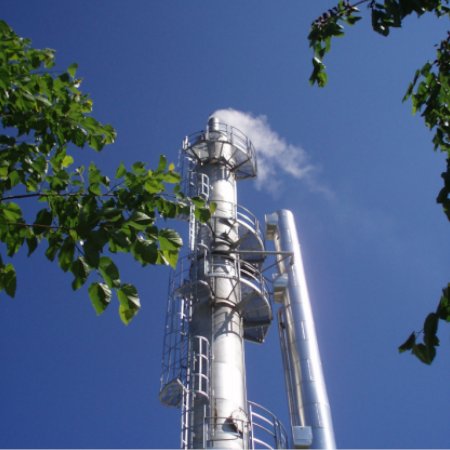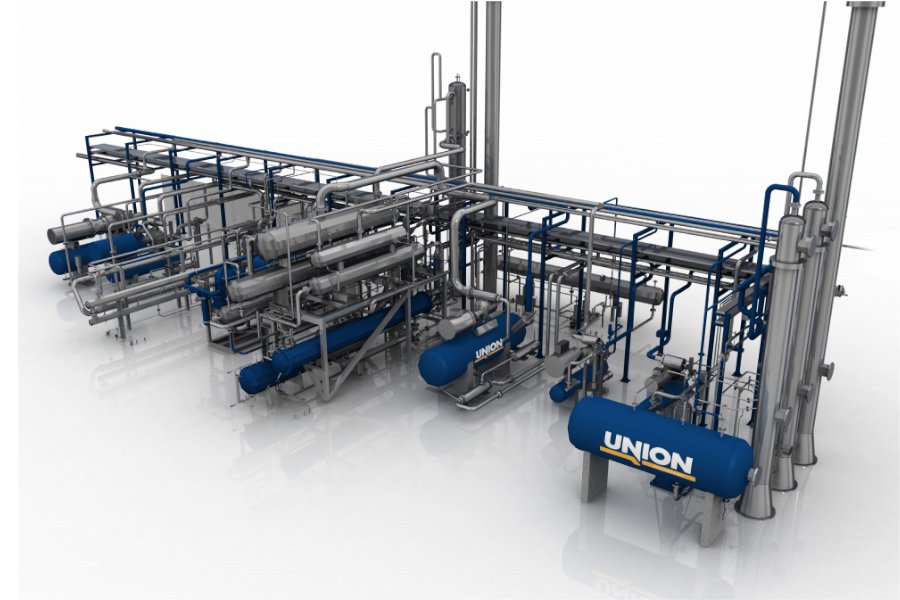The capture plants from Union Engineering are based on the most well-proven absorption technology currently available on the market, namely high concentrated monoethanolamine (MEA). MEA is a primary amine that reacts readily with carbon dioxide. Since the reaction is purely chemical absorption, it works well with gas streams having low partial CO2 pressure, as is the case for flue gases.
Once the carbon dioxide is captured in the MEA solution it is transferred to a stripping system. Here it is again released from the MEA solution by increasing the temperature of the solution to a point where the chemical reaction that took place in the absorber is reversed.
Benefits
- Low-pressure streams.
- High CO2 reaction rate.
- Tolerate high oxygen content.
- Non-corrosive.
- High CO2 loading.
- Low circulation rates.
- Low energy demand for regeneration.
- Low total energy demand.
-
PROCESS DESCRIPTION
-
Advanced Amine Technology, the most economical route for CO2 removal from flue gases.
Low purity CO2 raw gas is sourced from the combustion of fossil fuel, lime, or cement kilns and requires an upgrading unit to make it feasible for use in a CO2 liquefaction unit.
Low purity raw gas has a CO2 concentration less than 10–12 percent. By utilizing Union’s absorption and stripping technologies you can turn a low purity raw gas into a 99%+ high-quality CO2 gas. This stream can either be used directly in gaseous form or be further purified and liquefied to meet the strictest requirements for food and beverage grade carbon dioxide in accordance with specifications from regulators like the International Society of Beverage Technologists (ISBT).
The capture technology (up-grading unit) from Union Engineering is based on the most well-proven absorption technology currently available on the market, namely high concentrated 35% merchant Mono Ethanol Amine (MEA). Due to the high MEA concentration, the MEA circulations rates are 4 times less compared to a traditional low concentration MEA extraction system. MEA is a primary amine that reacts readily with carbon dioxide. Since the reaction is purely chemical absorption, it works well with gas streams having low partial CO2 pressure, as is the case for flue gases.
Unique and patented technologies allow Oxygen concentrations up to as much as 15% in the flue gas without degrading the amine.
Our reclaimer design efficiently removes the heat-stable salts which are formed when amine reacts with the flue gas. Accordingly, no corrosion inhibitor is required to run our plant safely. The risk of corrosion is eliminated and degradation of amine is reduced to a minimum.
If other impurities like SOx and NOx are present these are removed utilizing dedicated technologies and/or process designs developed by Union Engineering, e.g the patented NOx Flash and the SCR DENOX.
Every process plant we design is highly customized and specifically designed to meet any client specification.
Our plants are supplied with fully customized PLC systems, Operator Interphase (HMI systems), and DCS systems, upon request.

Downloads
| Title | Download PDF | |
| Product leaflet | Low Purity Advanced Amine Capture Plants |
Download |
| Technical documentation | Looking for operating instructions, installation manual, spare part list etc.? | Please, send us your request |
Related Products
The Truck Filling Unit is designed for an easy loading and unloading of liquid CO2.
Replaces scrubbing with Potassium Permanganate (PPM) in your CO2 production plant.




